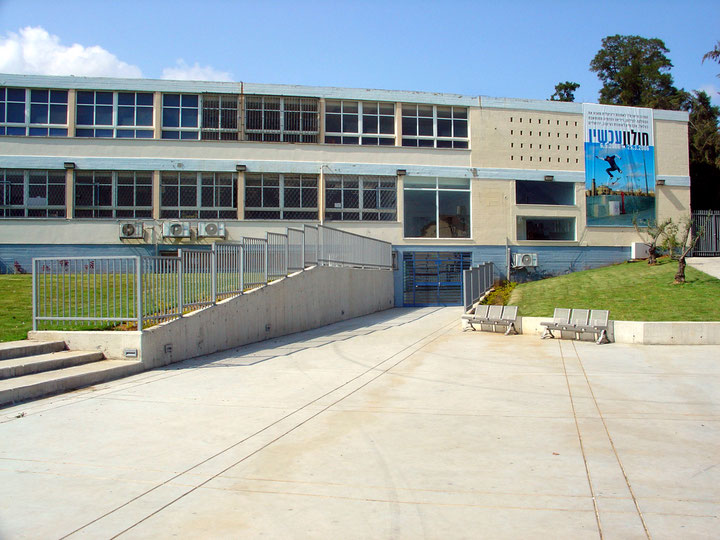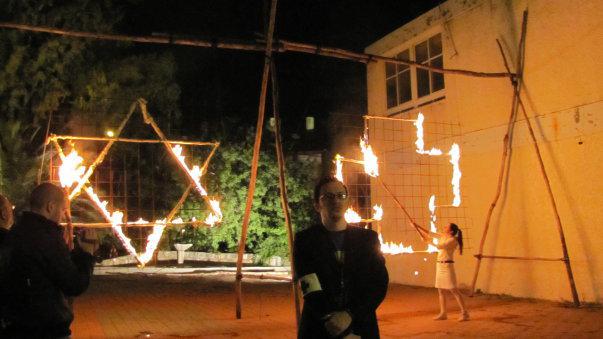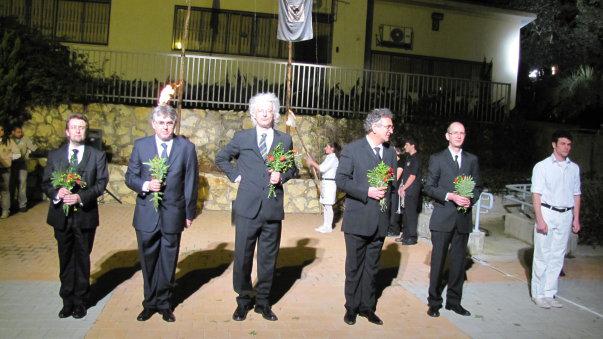The Israeli Center for Digital Art in Holon, also known as the DigitalArtLab (DAL), is not just one of the most interesting contemporary art venues in Israel, but is also a space in which to experiment with strategies and processes of social change. Eyal Danon has been running the DAL ever since the centre’s founding director, Galit Eilat, moved back to the Netherlands.
Originally the mayor of Holon, a grey industrialised city in the environs of Tel Aviv, simply intended to open a video gallery. Galit Eilat suggested turning it into a Centre for New Media and became its first director. After starting out as a small gallery room, the Centre soon expanded, moving into a large, two-storey school building. However, media art did not remain the sole focus for long: »It was the height of the second intifada«, explains Eyal Danon, who soon joined the project as a second curator: »We couldn’t simply ignore that reality«. He talks about socio-political topics, new communication approaches and »art production during wartime«.
Previously Danon had created the project »Autobiography of a City« in conjunction with Sami Bukhari. The project explores the history of Jaffa, now part of Tel Aviv – Yafo, to give the city its official name, was formerly the most important Palestinian city. However 95 per cent of the non-Jewish inhabitants were expelled in 1948. However Israeli official narratives of »a country without people for a people without a country« leave no room to address the events described by Palestinians as the Nakba, the catastrophe. This art project seeks to counteract that.1 »Autobiography of a City« collects stories from both Jewish and Arab inhabitants who lived here in harmony until 1948. Some of them are walking history books, such as Hiri Abu al Jibein, who can trace his family history back to the days before Napoleon’s destruction of the city in 1799.2
The other thrust of DAL’s work is defined by two more long-term projects: »Hilchot Shchenim« was an attempt to break out of the isolation that Israel has manoeuvred itself into since it was founded in 1948. The title of the three-part exhibition project is derived from the »Mishne Torah« of Maimonides, which is a medieval compilation of Talmudic legal interpretations and signifies »Rules for Neighbours«. Contacts and exchanges with similar institutions, primarily in the Balkan and Mediterranean area, also offered an opportunity to explore artistic tactics and scope for action.3
However, at the same time Israel began to isolate itself still further by constructing the separation barrier. On 1st April 2004 the group »Artists Without Walls«, an informal alliance of discontented citizens, which Eilat and Danon are involved in, fixed video cameras to both sides of the wall in a spectacular intervention in Abu Dis and beamed images from each side of the wall to the other side, thus overcoming the separation virtually for a moment. »However, it was already clear to us on 2nd April«, Danon affirms today, »that we couldn’t set anything in opposition to the barrier like that«.
»April 1st« did however pave the way for lasting contacts with partners in occupied West Jordan. The second long-term project has been taking steps to consolidate this exchange ever since 2006: for eight months »Liminal Spaces«, designed by Eilat and Danon in conjunction with Reem Fadda, Director of the Palestinian Association for Contemporary Art (PACA), and Philipp Misselwitz from the Universität der Künste Berlin, brought together curators and artists from the West Bank, Israel and various European countries. There had already been numerous cross-border projects. However there was a growing sense on both sides that this type of cooperation served solely to conceal a sustained policy of confrontation, occupation and expulsion, so that ultimately the Palestinian side had called for a boycott of Israeli cultural institutions. Obtaining an authorisation from the Boycott Committee at Birzeit University formed part of the project, along with researching the legal and practical problems involved in crossing the border.4
Israeli citizens are not permitted to spend time in Zone A of the West Bank, Danon explains, but adds when asked for more details that this is a military order arising from the occupation. Officially Zone A has been under Palestinian control since the Oslo Treaties. However, to cite Danon: »Whenever Israel wants to go in, it goes in with the army«. There is a lack of clarity about the border, he explains, for Israel has systematically blurred the Green Line since 1967. Anyhow, checks are only carried out for travel into Israel: »The checkpoints are only for the Palestinians«. It is much more difficult for Palestinians to enter Israel: »It’s all based on language and skin colour. If they can tell by your appearance and fluent Hebrew that you’re one of ›us‹, they simply wave you through – papers are irrelevant«.
»Liminal Spaces« was originally conceived as an exhibition project. However, it did not develop beyond a series of conferences, with an accompanying reader produced in 2009. This compendium, which is well worth reading, sheds light on the conflict in the Middle East, exploring the issues in unusual depth – for example in Khaled Hourani’s description of crossing the border in the Gaza Strip or Salim Tamari and Rema Hammami’s depiction of the way in which people living in refugee camps in the West Bank view the city of their grandparents, Jaffa. Further examples of this approach in the reader include Francis McKee presenting insights into the situation in Northern Ireland by way of comparison, or Yochai Avrahami’s research on Uzi Gal alias Gotthard Glas, the inventor of the Uzi submachine gun: Gal was the son of a Bauhaus pupil and a pioneer of aerial photography, utilised as part of the Israeli seizure of land in 1948.5
»Liminal Spaces« provided a basis for continuing contacts, comprehensive knowledge and far-reaching reflections on the function and scope for art to take action in a situation shaped by war and conflict. Further projects, such as the most recent solo exhibition by Sean Snyder, »The Real War«, pick up on this.6 In the process an archive was created, comprising1,500 video works, first exhibited in 2007 in Hamburg, and subsequently in other venues from Gdansk to New York, and most recently in Priština, with the host institution adding 25 works to the archive each time.7 The DAL also publishes »Ma’arav« (ambush), probably the most important Israeli contemporary art journal at present.8
One of the extraordinary artistic projects invited by DAL last year is the »Black Market of Useful Knowledge and Non-Knowledge« by the MobileAcademy from Berlin. In keeping with the rules of the game for the project, in September 2009 100 experts each provided information on a topic for half an hour in Jaffa, whilst this time around the event was especially topical due to the location and the participation of human rights activists, representatives of Palestinians who are also Israeli citizens, such as Knesset MP Haneen Zoabi, along with critical academics and artists.9 To cite just two examples: Gish Amit talked about the institutionalised pillage of Palestinian works from Jerusalem’s National Library, whilst Yael Bartana presented her provocative project for a Jewish settlement in Warsaw, which she has since developed further.10
In February 2010 IRWIN, the artistic department of NSK (Neue Slowenische Kunst), was a guest in Holon. NSK works on the principle of over-identification, in other words, the appropriation of national and totalitarian symbols, insignia and rites.11 The phantoms of the National Socialist past also seem to make their way down some labyrinthine route as they awaken from their slumbers when flags are hoisted, torches lit, drums rolled and fanfares ring out to welcome the Israeli group »Public Movement«, whilst a delegation of honour stands to attention.12 Perhaps bringing these phantoms out into the open like this offers the best prospect of finally ridding ourselves of them.
http://www.digitalartlab.org
Interview with Eyal Danon together with other material, inter alia on »Artists Without Walls« and »Autobiography of a City«, at: http://www.theaterofpeace.org
Translated by Helen Ferguson
1 Like the Israeli initiative Zochrot, which promotes awareness of the Nakba; http://www.zochrot.org/index.php?id=642.
2 http://www.jaffaproject.org; organised by Ayam – Recognition and Dialogue.
3 Chapter A, 6.12.2003–28.2. 2004; Chapter B, 24.4.–24.6.2004; Chapter C, 16.4.–16.7.2005; c.f. Nat Muller, Benachbarte Taktiken, in: springerin 4/2004, pp. 10–12; http://www.digitalartlab.org.il/ExhibitionsList.asp.
4 http://liminalspaces.org
5 Liminal Spaces 2006–2009, Holon 2009; conferences in Kalandia, Leipzig and various other venues.
6 29.5.–14.8.2010.
7 http://mobilearchive.digitalartlab.org.il/?page_id=11.
8 http://www.maarav.org.il/english
9 Jaffa, 26.9.2009, DAL and Ayam; http://www.mobileacademy-berlin.com/englisch/2009/s_jaffa.html; http://www.digitalartlab.org.il/ExhibitionPage.asp?id=367&path=level_1; http://www.blackmarket-archive.com.
10 Most recently: We will be strong in our weakness. Notes from the First Congress of the Jewish Renaissance in Poland, Performance, Hebbel am Ufer. Berlin, 25.5.2010.
11 The term was coined by Slavoj Žižek; NSK was founded in 1984 and includes the band Laibach; the use of the German designations (Laibach = Ljubljana) should be understood as a provocation: part of the project is a »state within time« with Kasimir Malevich’s black cross as the symbol on the flag; c.f. Inke Arns, Neue Slowenische Kunst. Eine Analyse ihrer künstlerischen Strategien im Kontext der 1980er Jahre in Jugoslawien. Regensburg 2002; http://theinfluencers.org/en/irwin; http://www.nskstate.com.
12 IRWIN: The Eye of the State, 6.2.–10.4.2010; http://publicmovementenglish.blogspot.com.


